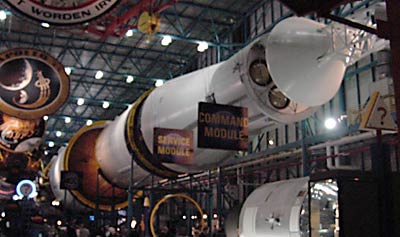Restoring the wonder<< page 1: it began with Bonestell Restoring the wonderThe wonder of space exploration rose during the 1950s, accelerated during the 1960s and reached its apex on July 20, 1969 with the first moon landing, an event watched by hundreds of millions around the world. Amidst the euphoria at the successful return of astronauts Armstrong, Collins and Aldrin, interest—and wonder—in lunar exploration curiously began to wane. The excitement of the unknown, even the danger involved, almost became commonplace. The spectacular discoveries made possible by the lunar roverz on Apollo 15, 16 and 17 proved what could be accomplished in exploring the moon, but the epitaph for the manned lunar mission had by then been written. Americans all but snoozed through the Skylab missions and the Apollo-Soyuz Test Project.
With the advent of the space shuttle and International Space Station, the visions of Bonestell, von Braun, and others became a reality. Wonder is difficult to maintain when such visions become routine, but they do not lessen the challenges or the extreme dangers involved in space exploration. NASA has run probabilities for its manned missions for decades. At a brunch with Apollo astronauts Edgar Mitchell, John Young, Charlie Duke and Eugene Cernan at the KSC Visitors Center this month, Young revealed that those responsible for running the stats for the probable success of his Apollo 16 mission only gave him a one-in-five chance of returning to Earth. Knowing that makes the successful completion of Apollo all the more extraordinary. All past and present astronauts are fully aware of the perils involved. The shuttle astronauts are especially aware of this, as there is no means of crew escape on ascent and there are obviously no guarantees on re-entry, either. That has always been a sobering fact of the space shuttle and it has already had a bearing on the design of the future Crew Exploration Vehicle. Mitchell, Young, Duke and Cernan all emphasized, however, that manned exploration of our solar system is not only essential, but inevitable. Cernan stated the generation that would return to the moon and move on to explore Mars is alive right now, and they must be encouraged to seek those goals while they are still young. As it did for Kathryn Sullivan and countless others, it will begin with wonder. The future ranks of aerospace engineers, software engineers, designers, scientists, mathematicians, and all the other careers vital to space exploration are currently in elementary, middle and high schools today. Much can be done to encourage them, as Cernan emphatically stated, “…to shoot for the Moon.” The next generationDr. Sullivan also spoke about the need to inspire students, and she has the perfect vehicle to do it. Today, she is president and CEO of the COSI science museum in Columbus, Ohio. COSI opened its doors in 1964 and has grown in size and scope since then. More than 15 million visitors have been motivated by COSI’s science learning programs in the four decades since. In 1999 it opened its doors to a new 30,000 square-meter facility that features interactive discovery-based and themed exhibit areas, theaters, and an outdoor science park that all creatively combine science facts and learning through interactivity. COSI, and other facilities like it, are having a positive impact on the next generation of professionals who will one day be involved in space exploration one way or another. The President’s Commission on Implementation of U.S. Space Exploration Policy held it’s fourth of five public hearings in April at the Galileo Academy of Science and Technology in San Francisco. The emphasis at this hearing was on education. Barbara Morgan, NASA’s educator astronaut, spoke before the commission. She trained as Christa McAuliffe’s backup from 1985 to 1986, but essentially became an earthbound teacher-astronaut in the years since the Challenger disaster. She will finally get her chance on STS-118 scheduled for launch in 2006. “The Moon-Mars initiative offers us a tremendous opportunity for education if we make sure from the beginning that teachers see themselves as part of the effort,” Morgan told the Commission. “No one can offer the lifelong enthusiasm better than someone who is teaching a subject for which he or she has a passion for.”
NASA has the Explorer School Program in 50 schools around the country. The program stresses math and science while at the same time extolling the space agency, but Morgan admitted there need to be many more schools involved. Until that happens, students can turn to NASA’s own superb websites that cover the Jet Propulsion Laboratory, International Space Station, Hubble Space Telescope, Human Space Flight, and many others. Few places on earth can inspire wonder in space exploration better than Kennedy Space Center Visitor’s Center. For a young child or teenager, it is one big space toy store. How many children have been inspired to pursue aerospace careers after visiting KSCVC is anyone’s guess. Even the most jaded adult will watch the IMAX film ‘The International Space Station’ with child-like wonder, and gain a new appreciation for the immense complexity of this program. Today, the United States has many more venues to inspire a new generation to “reach for the Moon” than existed in previous decades. But future graduates who aspire to fields in space exploration must be able to set their sights on ongoing and concrete, future exploration programs. Not only must this generation receive the necessary education and motivation to pursue such careers, there must be programs for them to enter. Nevertheless, without the needed brainpower, such programs will be understaffed or not exist at all. America is on the threshold of a new era of space exploration. The country needs both the people and the vision to accomplish that. Home |
|
